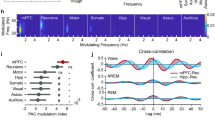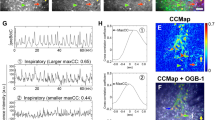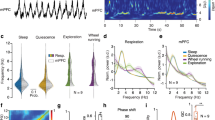Abstract
Breathing must be tightly coordinated with other behaviours such as vocalization, swallowing, and coughing. These behaviours occur after inspiration, during a respiratory phase termed postinspiration1. Failure to coordinate postinspiration with inspiration can result in aspiration pneumonia, the leading cause of death in Alzheimer’s disease, Parkinson’s disease, dementia, and other neurodegenerative diseases2. Here we describe an excitatory network that generates the neuronal correlate of postinspiratory activity in mice. Glutamatergic–cholinergic neurons form the basis of this network, and GABA (γ-aminobutyric acid)-mediated inhibition establishes the timing and coordination relative to inspiration. We refer to this network as the postinspiratory complex (PiCo). The PiCo has autonomous rhythm-generating properties and is necessary and sufficient for postinspiratory activity in vivo. The PiCo also shows distinct responses to neuromodulators when compared to other excitatory brainstem networks. On the basis of the discovery of the PiCo, we propose that each of the three phases of breathing is generated by a distinct excitatory network: the preBötzinger complex, which has been linked to inspiration3,4; the PiCo, as described here for the neuronal control of postinspiration; and the lateral parafacial region (pFL), which has been associated with active expiration, a respiratory phase that is recruited during high metabolic demand4,5.
This is a preview of subscription content, access via your institution
Access options
Subscribe to this journal
Receive 51 print issues and online access
$199.00 per year
only $3.90 per issue
Buy this article
- Purchase on Springer Link
- Instant access to full article PDF
Prices may be subject to local taxes which are calculated during checkout




Similar content being viewed by others
References
Richter, D. W. & Smith, J. C. Respiratory rhythm generation in vivo. Physiology (Bethesda) 29, 58–71 (2014)
Troche, M. S., Brandimore, A. E., Godoy, J. & Hegland, K. W. A framework for understanding shared substrates of airway protection. J. Appl. Oral Sci. 22, 251–260 (2014)
Smith, J. C., Ellenberger, H. H., Ballanyi, K., Richter, D. W. & Feldman, J. L. Pre-Botzinger complex: a brainstem region that may generate respiratory rhythm in mammals. Science 254, 726–729 (1991)
Huckstepp, R. T., Cardoza, K. P., Henderson, L. E. & Feldman, J. L. Role of parafacial nuclei in control of breathing in adult rats. J. Neurosci. 35, 1052–1067 (2015)
Pagliardini, S. et al. Active expiration induced by excitation of ventral medulla in adult anesthetized rats. J. Neurosci. 31, 2895–2905 (2011)
Smith, J. C., Abdala, A. P., Rybak, I. A. & Paton, J. F. Structural and functional architecture of respiratory networks in the mammalian brainstem. Phil. Trans. R. Soc. Lond. B 364, 2577–2587 (2009)
Smith, J. C., Abdala, A. P., Koizumi, H., Rybak, I. A. & Paton, J. F. Spatial and functional architecture of the mammalian brain stem respiratory network: a hierarchy of three oscillatory mechanisms. J. Neurophysiol. 98, 3370–3387 (2007)
Alheid, G. F. & McCrimmon, D. R. The chemical neuroanatomy of breathing. Respir. Physiol. Neurobiol. 164, 3–11 (2008)
Ruangkittisakul, A., Kottick, A., Picardo, M. C., Ballanyi, K. & Del Negro, C. A. Identification of the pre-Bötzinger complex inspiratory center in calibrated “sandwich” slices from newborn mice with fluorescent Dbx1 interneurons. Physiol. Rep. 2, e12111 (2014)
Tan, W. et al. Silencing preBötzinger complex somatostatin-expressing neurons induces persistent apnea in awake rats. Nat. Neurosci. 11, 538–540 (2008)
Lieske, S. P., Thoby-Brisson, M., Telgkamp, P. & Ramirez, J. M. Reconfiguration of the neural network controlling multiple breathing patterns: eupnea, sighs and gasps. Nat. Neurosci. 3, 600–607 (2000)
Hilaire, G., Viemari, J. C., Coulon, P., Simonneau, M. & Bévengut, M. Modulation of the respiratory rhythm generator by the pontine noradrenergic A5 and A6 groups in rodents. Respir. Physiol. Neurobiol. 143, 187–197 (2004)
Madisen, L. et al. A toolbox of Cre-dependent optogenetic transgenic mice for light-induced activation and silencing. Nat. Neurosci. 15, 793–802 (2012)
Onimaru, H., Arata, A. & Homma, I. Firing properties of respiratory rhythm generating neurons in the absence of synaptic transmission in rat medulla in vitro. Exp. Brain Res. 76, 530–536 (1989)
Gray, P. A. et al. Developmental origin of preBötzinger complex respiratory neurons. J. Neurosci. 30, 14883–14895 (2010)
Janczewski, W. A. & Feldman, J. L. Distinct rhythm generators for inspiration and expiration in the juvenile rat. J. Physiol. (Lond.) 570, 407–420 (2006)
Burke, P. G., Abbott, S. B., McMullan, S., Goodchild, A. K. & Pilowsky, P. M. Somatostatin selectively ablates post-inspiratory activity after injection into the Bötzinger complex. Neuroscience 167, 528–539 (2010)
Dutschmann, M. & Herbert, H. The Kölliker-Fuse nucleus gates the postinspiratory phase of the respiratory cycle to control inspiratory off-switch and upper airway resistance in rat. Eur. J. Neurosci. 24, 1071–1084 (2006)
Subramanian, H. H. & Holstege, G. Midbrain and medullary control of postinspiratory activity of the crural and costal diaphragm in vivo. J. Neurophysiol. 105, 2852–2862 (2011)
Grillner, S. The motor infrastructure: from ion channels to neuronal networks. Nat. Rev. Neurosci. 4, 573–586 (2003)
Kiehn, O. Locomotor circuits in the mammalian spinal cord. Annu. Rev. Neurosci. 29, 279–306 (2006)
Stein, P. S. Neuronal control of turtle hindlimb motor rhythms. J. Comp. Physiol. A Neuroethol. Sens. Neural Behav. Physiol. 191, 213–229 (2005)
Wiggin, T. D., Anderson, T. M., Eian, J., Peck, J. H. & Masino, M. A. Episodic swimming in the larval zebrafish is generated by a spatially distributed spinal network with modular functional organization. J. Neurophysiol. 108, 925–934 (2012)
Evans, J. A., Elliott, J. A. & Gorman, M. R. Dynamic interactions between coupled oscillators within the hamster circadian pacemaker. Behav. Neurosci. 124, 87–96 (2010)
Madisen, L. et al. A robust and high-throughput Cre reporting and characterization system for the whole mouse brain. Nat. Neurosci. 13, 133–140 (2010)
Hirata, T. et al. Identification of distinct telencephalic progenitor pools for neuronal diversity in the amygdala. Nat. Neurosci. 12, 141–149 (2009)
Hill, A. A., Garcia, A. J., III, Zanella, S., Upadhyaya, R. & Ramirez, J. M. Graded reductions in oxygenation evoke graded reconfiguration of the isolated respiratory network. J. Neurophysiol. 105, 625–639 (2011)
Telgkamp, P., Cao, Y. Q., Basbaum, A. I. & Ramirez, J. M. Long-term deprivation of substance P in PPT-A mutant mice alters the anoxic response of the isolated respiratory network. J. Neurophysiol. 88, 206–213 (2002)
Doi, A. & Ramirez, J. M. State-dependent interactions between excitatory neuromodulators in the neuronal control of breathing. J. Neurosci. 30, 8251–8262, (2010)
Franklin, K. & Paxinos, G. The Mouse Brain in Stereotaxic Coordinates, Third Edition (Academic, 2008)
Acknowledgements
Supported by grants from the National Institute of Health NS087828-01 (to T.M.A.), HL090554 (to J.-M.R.), and HL126523-01 (to J.-M.R.). We thank P. Gray for insights provided throughout the preparation of this manuscript, T. Dashevskiy for creating the heat map of postinspiratory activity, F. Bedogni for obtaining in situ hybridization reagents, and K. Cuthill for cryosectioning. J.-M.R. also thanks D. W. Richter and S. W. Schwarzacher for the inspiration to study postinspiration.
Reviewer Information
Nature thanks J. Bouvier, O. Kiehn and H. Zoghbi for their contribution to the peer review of this work.
Author information
Authors and Affiliations
Contributions
T.M.A, A.J.G., and J.-M.R. designed all experiments. T.M.A., A.J.G., N.A.B, J.P., J.C.B., A.D.W., and K.G.R. performed the experiments. T.M.A., A.J.G., N.A.B, and J.P. analysed the data. T.M.A., A.J.G., N.A.B, J.P., and J.-M.R. contributed to manuscript preparation. T.M.A. and J.-M.R wrote the manuscript.
Corresponding author
Ethics declarations
Competing interests
The authors declare no competing financial interests.
Extended data figures and tables
Extended Data Figure 1 Schematic of the horizontal slice from a sagittal view that retains the medullary ventral respiratory column in the brainstem.
Dotted lines represent approximate boundaries of the horizontal slice. Slice retains part of the superior olive (SO), and the entire retrotrapezoidal nucleus/para-facial respiratory group (RTN/pFRG), facial nucleus (VII N), Bötzinger complex (BötC), postinspiratory complex (PiCo), nucleus ambiguus (NA), preBötzinger complex (preBötC), lateral reticular nucleus (LRT), and the rostral and caudal ventral respiratory groups (rVRG and cVRG, respectively). The slice also retains a portion of the spinal cord and includes part of the phrenic motor nucleus (approximately cervical segments 3 and 4). The slice does not contain the dorsal portion of the medulla including the dorsal respiratory group (DRG). Dorsal (D), ventral (V), rostral (R), caudal (C).
Extended Data Figure 2 Norepinephrine dose response of preBötC and PiCo rhythms in horizontal and transverse slices.
The frequency of the PiCo rhythm (black) is highly sensitive to the application of low concentrations of norepinephrine while the preBötC rhythm (purple) stays relatively constant in both types of slice preparations. a, In horizontal slices the PiCo rhythm is slow under spontaneous conditions (n = 10), the two rhythms have similar burst frequencies in the presence of 2 μM norepinephrine (n = 6), and the PiCo rhythm significantly outpaces the preBötC rhythm under higher concentrations of norepinephrine (n = 4, 3–4 μM norepinephrine). b, Similarly, when isolated in transverse slices, the PiCo rhythm has a slow frequency under spontaneous conditions (n = 10), and the preBötC and PiCo have similar frequencies at 2 μM norepinephrine (n = 7; mean ± s.e.m.). Two-way ANOVA followed by a Bonferroni post-hoc test. ****P < 0.0001 comparing PiCo to preBötC, ϕP < 0.05 compared to baseline (Spon.), #P < 0.05 compared to 2 μM norepinephrine.
Extended Data Figure 3 Nucleus ambiguus neurons lack Vglut2–cre expression.
High magnification view at the level of PiCo from a Vglut2-cre;Ai6 (ZsGreen1; green) mouse immunolabelled with ChAT antibody (magenta) and Cre antibody (white). Note lack of green Vglut2–cre expression in the nucleus ambiguus. Scale bar, 100 μm.
Extended Data Figure 4 Progressive synaptic blockade in horizontal and transverse slices.
Left, graphs comparing frequency and normalized burst area between horizontal (n = 5) and paired transverse slices (n = 5) after the application of strychnine and gabazine. In both horizontal and paired transverse slices, PiCo and preBötC rhythms have nearly identical burst frequencies in the presence of gabazine (top). The burst area of both rhythms also significantly increases with the application of gabazine in both slice preparations (bottom). Two-way ANOVA followed by a Bonferroni post-hoc test. ϕP < 0.05 compared to baseline (2 μM norepinephrine). Right, synaptic blockers were progressively perfused over paired transverse slices at 10-min intervals. Both PiCo and preBötC rhythms persist in the presence of 1 μM strychnine, 10 μM gabazine, and 10 μM CPP. Population rhythms ceased in the presence of 20 μM CNQX, indicating that both rhythms are excitatory (n = 5). The asterisk denotes a characteristic sigh in the preBötC trace.
Extended Data Figure 5 Peri-event interval between preBötC and PiCo bursts during inhibitory block in the horizontal slice.
a, Peri-event interval, time between peak of preBötC and PiCo bursts, is constant in strychnine; however, gabazine initiates progressive synchronization between rhythms (shown here in a representative experiment). b, Average peri-event intervals at baseline and after sequential application of strychnine and gabazine (n = 6, mean ± s.e.m.). Repeated measures Friedman test followed by Dunn’s multiple comparisons post-hoc test. *P < 0.05.
Extended Data Figure 6 Blocking muscarinic and nicotinic acetylcholine receptors does not abolish the PiCo rhythm.
a, Raw population bursts from PiCo and contralateral preBötC with the progressive addition of 1 μM mecamylamine (nicotinic receptor antagonist), 10 μM atropine (muscarinic receptor antagonist), and 4 μM norepinephrine. b, The left two graphs show n = 5 experiments in which atropine was applied first, and the right graphs illustrate n = 3 experiments in which mecamylamine was applied first. Blockade of muscarinic receptors results in a larger decrease in PiCo burst frequency than blocking nicotinic receptors, while preBötC frequency does not change significantly (top graphs). Blockade of muscarinic receptors increases the amplitude of PiCo bursts (bottom graphs). The PiCo rhythm persists after concurrent blockade of both types of acetylcholine receptors, and PiCo burst frequency rebounds to near baseline levels when an additional 2 μM norepinephrine is applied (total 4 μM norepinephrine; top graphs; mean ± s.e.m.). Two-way ANOVA followed by a Bonferroni post-hoc test. **P < 0.01, *P < 0.05 comparing preBötC to PiCo, ϕP < 0.05 compared to baseline (2 μM norepinephrine).
Extended Data Figure 7 Synaptically isolated PiCo neurons decrease firing frequency in the presence of DAMGO.
a, Top traces show intracellular recordings from PiCo cells with concurrent extracellular preBötC population activity from a horizontal slice under 1 μM norepinephrine baseline conditions. Bottom traces show the same recordings after blocking fast synaptic transmission (1 μM strychnine, 10 μM gabazine, 10 μM CPP, 20 μM CNQX) to synaptically isolate PiCo neurons. Application of 10 nM DAMGO decreases the cell’s intrinsic firing frequency. b, Quantified data show that DAMGO significantly decreases action potential (AP) firing frequency of synaptically isolated PiCo neurons in both horizontal slices (black dots) and transverse PiCo slices (grey dots) (two-tailed paired t-test, *P < 0.05; n = 5).
Extended Data Figure 8 Differential PiCo and preBötC population responses to DAMGO and SST in horizontal and transverse slices.
a, After the application of 25 nM DAMGO, preBötC burst frequency decreases only slightly (n = 5), whereas PiCo bursting is nearly eliminated. b, Similar to results observed in horizontal slices, the PiCo rhythm is eliminated by 25 nM DAMGO in transverse slices that isolate PiCo and preBötC in the presence of 2 μM norepinephrine (n = 5). Periodic large amplitude bursts in the bottom preBötC trace are fictive sighs. c, DAMGO dose response of normalized preBötC and PiCo burst frequency in transverse slices, illustrating the differential sensitivity of the PiCo and preBötC rhythms to DAMGO; burst frequency values are normalized to baseline frequency in 2 μM norepinephrine (mean ± s.e.m., n = 8 with minimum replicates of 4 for each location and concentration). d, The PiCo rhythm is selectively and transiently inhibited by the application of 500 nM SST whereas the preBötC rhythm persists in horizontal slices. Graph shows normalized average burst frequencies of both rhythms at baseline, 1.5–3.5 min after SST application, and 8–10 min after SST application (n = 6). e, Similar to the horizontal slice, SST application results in a robust inhibition of PiCo bursting in paired transverse slices. f, Similar to d, complied normalized burst frequencies for n = 6 transverse slices before and after SST application. (mean ± s.e.m.) Two-way ANOVA followed by a Bonferroni post-hoc test. ****P < 0.0001 comparing PiCo to preBötC, ϕP < 0.05 compared to baseline.
Extended Data Figure 9 Light stimulation of cholinergic cells evokes postinspiratory activity in horizontal slices and in vivo.
a, Two population electrodes were placed at the level of PiCo (black dot and trace) and contralateral preBötC (purple dot and trace) in a horizontal slice from a Chat-cre;Ai27 mouse. Under spontaneous conditions (no norepinephrine), cholinergic neurons expressing channelrhodopsin-2 were light activated with an optical fibre (labelled ‘light’) placed over the PiCo ipsilateral to the preBötC electrode. PiCo population bursts were triggered upon the onset of a 1.5-s light pulse whereas no bursts were light evoked in the preBötC (n = 6). Figure shows 10 traces overlaid for each electrode with averaged traces below from a representative experiment. b, Photo-stimulating PiCo in adult anaesthetized Chat-cre;Ai27 mice reliably triggers cVN bursts. Figure shows 10 traces overlaid with averages below of cVN and XII activity during a 200-ms light stimulation of PiCo. c, Postinspiratory bursts can be photo-evoked both in vivo (n = 6) and in vitro (n = 6) at any phase except for during inspiration and just before inspiration (bottom left) owing to the inspiratory phase delay that occurs when PiCo is stimulated (mean ± s.e.m., bottom right).
Extended Data Figure 10 Elimination of phase delay by DAMGO and diversity of postinspiratory waveforms in vivo.
a, Injection of 5 μM DAMGO into the PiCo eliminates the phase delay elicited by photostimulation of PiCo in Chat-cre;Ai27 mice. A representative experiment showing cVN and XII recordings during a 200-ms light pulse before and after injection of PiCo with DAMGO (left; grey bars, expected phase; purple bars, inspiratory phase delay) and the average inspiratory phase delay (right) (mean ± s.e.m., two-tailed paired t-test, **P < 0.01; n = 6). b, Diverse postinspiratory vagal waveforms were recorded in vivo. Five examples of cVN (black) and XII (purple) recordings (overlaid) show that postinspiratory activity can vary from large decrementing patterns to small short bursts, potentially representing the neural basis of a variety of postinspiratory behaviours.
Rights and permissions
About this article
Cite this article
Anderson, T., Garcia, A., Baertsch, N. et al. A novel excitatory network for the control of breathing. Nature 536, 76–80 (2016). https://doi.org/10.1038/nature18944
Received:
Accepted:
Published:
Issue Date:
DOI: https://doi.org/10.1038/nature18944
This article is cited by
-
Latent neural population dynamics underlying breathing, opioid-induced respiratory depression and gasping
Nature Neuroscience (2024)
-
SubSol-HIe is an AMPK-dependent hypoxia-responsive subnucleus of the nucleus tractus solitarius that coordinates the hypoxic ventilatory response and protects against apnoea in mice
Pflügers Archiv - European Journal of Physiology (2024)
-
Synchronization of inspiratory burst onset along the ventral respiratory column in the neonate mouse is mediated by electrotonic coupling
BMC Biology (2023)
-
Hydrogen sulfide production in the medullary respiratory center modulates the neural circuit for respiratory pattern and rhythm generations
Scientific Reports (2023)
-
Mafa-dependent GABAergic activity promotes mouse neonatal apneas
Nature Communications (2022)
Comments
By submitting a comment you agree to abide by our Terms and Community Guidelines. If you find something abusive or that does not comply with our terms or guidelines please flag it as inappropriate.



